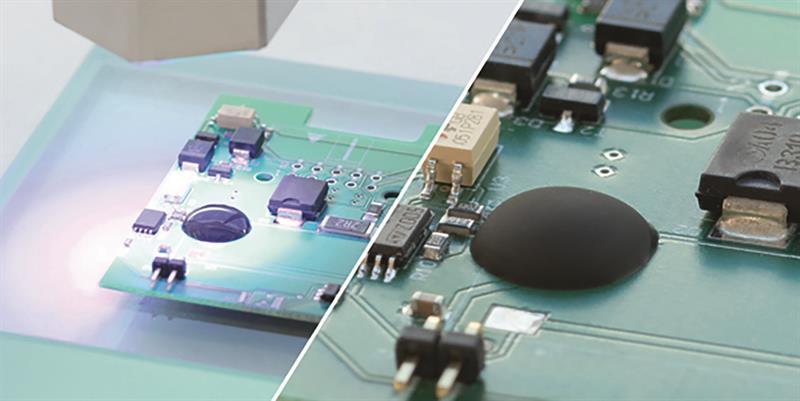With end-products getting smaller and lighter, mechanical fixing methods such as screws are becoming less of an option and adhesives are increasingly employed. There is a wide variety of adhesive types available, differing mainly in terms of their chemistries and whether they are one- or two-part solutions. They also vary in terms of performance, with parameters including bond strength and resistance to temperature and chemicals.
Adhesive used in electronics include the bonding of bare semiconductor die and of surface-mount devices (SMDs) to various substrates and providing additional connection strength for components with relatively high masses – and which might shake free if the end-product is exposed to high vibration levels – and for the encapsulation (potting) of electronic components.
Accordingly, adhesives are regularly tasked with bonding materials including silicon, gallium arsenide and gallium nitride to hardened epoxies (such as FR-4) and ceramic-based substrates. Adhesives are also used to bond assembly parts and to secure screens.
Single cure
Whilst many adhesives are room-temperature (RT) curing, these tend not to be used in electronics manufacturing because they take too long to cure. Instead, heat- or light-cured adhesives are used.
Heat curing requires the use of an industrial oven, for temperatures ranging from 60°C upwards. The benefits of heat curing include the creation of a very strong bond at a much faster rate than curing at room temperature. This is ideal for volume production scenarios, and many heat-cured adhesives can tolerate subsequent exposure to heat without weakening.
However, not all substrate materials or electronic components are suitable for exposure to high temperatures and the temptation is to cure at a lower-than-optimal temperature for longer. Beware though, as the longer cure time is not the only penalty. You risk reducing the overall efficacy of the adhesive.
Another drawback is that once the adhesive is placed between the electronic component and the substrate, the low viscosity of the uncured adhesive allows some movement of the devices. Though the movement, possibly as a result of transfer to the oven, might only be slight for some devices, such as an electro-optic sensor being placed within a glass-lidded package, any misalignment could compromise performance.
An alternative to heat-curing is light-curing. Light-cured adhesives cure at room temperate when exposed to UV or visible light from high energy LED lamps that generate 100 to 1000 times the intensity of normal daylight. They are useful for bonding a wide range of materials and can do so extremely quickly. The UV-curing process, in particular, can take less than 10 seconds.
However, up until recently, this adhesive type was relatively uncommon in electronics manufacturing because of an obvious drawback. If the light cannot reach the adhesive it will not cure. On a densely populated substrate, for example, it becomes difficult for the light to penetrate much beyond the edges of the components.

Photo courtesy of DELO.
Best of both worlds
Dual-cured adhesives combine the benefits of both single cure types discussed above, typically delivering overall time-savings and an increased yield. This adhesive type is especially useful in microelectronics and for semiconductor die attach. As mentioned, light-cure may only work on the edges of a component but that is often enough to tack it in place and prevent movement during transfer to an oven, where heat will cure the adhesive that is in the ‘shadow zone’.
There are several types of dual-curing adhesive. The first is heat-curing mandatory but with light-curing optional; as not all components may need the latter. The second type has independent light- and heat-curing mechanisms, where you can use just one or both methods depending on the requirements of the application. Accordingly, it may be possible that one adhesive could be used for several different bonding applications.
In terms of chemistries, a heat-and-light-cured adhesive will be either an epoxy or an acrylate. The former is more suited to providing resistance to chemicals and extreme temperatures and is physically harder. Acrylates on the other hand are normally softer and quicker to cure, resulting in a more flexible cured adhesive. Dual-curing allows temperature-sensitive materials to be bonded using modified epoxies that can cure at temperatures as low as 60°C.
However, for applications where even a low heat is not an option, an alternative is light-and-humidity- curing adhesives, where most of the resin is cured with light and the rest reacts with the natural humidity in the shadowed areas. This technique is used in the manufacture of smartphones, during which the adhesive under the border of the screen cures by air but the transparent section cures by light. If the majority of the process is light-cured, the bond will be very strong.
While requiring more light coverage than is always possible, this presents the advantage that no further processes are required after light-curing has finished, whereas it would need to be baked in an oven if it was a light- and heat-based dual-cure adhesive. The disadvantage of this method is that it takes longer to cure, but the adhesive is highly flexible and ideal for fixing on surfaces such as glass because it is optically transparent.
Another alternative is light- and anaerobic-cured adhesives, which cure in the presence of metal and the absence of oxygen. Typically, in anaerobic applications some of the adhesive at the edge of the joint is left exposed to air, meaning that it remains partially uncured. By combining this method with a light-curing component, the adhesive exposed to air can be snap cured, allowing a full coverage.
Ideal solution
Fixing components is highly important in electronics production and assembly and presents manufacturers with various challenges. The benefits, therefore, of a versatile dual-curing adhesive are clear; to give you an increased yield and a better process overall. In many applications, single-curing is a valid option but for the electronics industry, it is difficult to look past the efficacy and efficiency of a dual-cure solution. They ensure the benefits of two separate adhesives complement each other, giving you the peace of mind that their fixings are comprehensive and secure.









